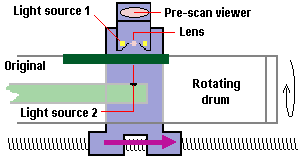PMT is the sensor technology used by the high-end drum scanners used by colour prepress companies. Expensive and difficult to operate, these were the devices used to load images into a computer before the advent of desktop scanning.
Technicians would carefully mount originals onto a cylindrical drum which would then be spun at high speed. The machine would then be moved – via a mechanically accurate threaded shaft – initially to align its optical sensor with the original and then slowly across its entire span as the item was scanned. Variation to output size can be assisted with variable sideways carriage movement, different lenses for various reproduction ranges and different drum circumferences.

PMT scanners have two light sources, one for reflective original and one for transparent originals. The light detected by the sensor is split into three beams which are passed through red, green and blue filters and thence into the photomultiplier tubes – where the light energy is converted into an electrical signal. PMTs have a much higher sensitivity to light and lower noise levels than CCD scanners. Consequently, drum scanners are capable of excellent tonal resolution, being less susceptible to errors due to refraction or focus than their flatbed counterparts
However, drum scanners are slow compared to CCD scanners and are expensive. These days they’re are generally used only for specialised high-end applications.